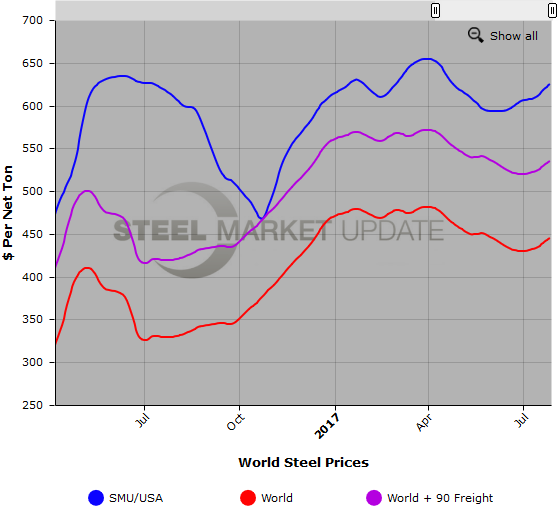International Steel Prices

Foreign vs. Domestic Hot Rolled Price Comparison
Written by Brett Linton
July 27, 2017
The following calculation is used by Steel Market Update to identify the theoretical spread between foreign hot rolled steel import prices (delivered to USA ports) and domestic (USA) hot rolled coil prices (FOB Domestic mills). We want our readers to be aware that this is only a “theoretical” calculation as freight costs, trader margin and other costs can fluctuate, ultimately influencing the true market spread.
Our primary numbers for this analysis are from Platts as we compare European HRC export pricing (FOB Ruhr), Turkey HRC export pricing (FOB Turkey) and Chinese HRC export pricing (FOB Chinese port). Be aware that Chinese hot rolled pricing is not available to the U.S. market, so the Chinese spread is nothing more than an exercise in “what if.” SteelBenchmarker is the secondary data provider of foreign hot rolled coil prices and is noted further down in this article.
![]() SMU adds $90 per ton to these foreign prices taking into consideration freight costs, handling, trader margin, etc. This provides an approximate “CIF U.S. ports price” that can then be compared against the SMU U.S. hot rolled price average (FOB Mill), with the result being the spread (difference) between domestic and foreign hot rolled prices. As the price spread narrows, the competitiveness of imported steel into the United States is reduced. If the spread widens, then foreign steel becomes more attractive to U.S. flat rolled steel buyers. A positive spread means U.S. prices are theoretically higher than foreign prices, while a negative spread means U.S. prices are cheaper than foreign prices.
SMU adds $90 per ton to these foreign prices taking into consideration freight costs, handling, trader margin, etc. This provides an approximate “CIF U.S. ports price” that can then be compared against the SMU U.S. hot rolled price average (FOB Mill), with the result being the spread (difference) between domestic and foreign hot rolled prices. As the price spread narrows, the competitiveness of imported steel into the United States is reduced. If the spread widens, then foreign steel becomes more attractive to U.S. flat rolled steel buyers. A positive spread means U.S. prices are theoretically higher than foreign prices, while a negative spread means U.S. prices are cheaper than foreign prices.
As of today (Thursday, July 27), Platts published European HRC prices at $530 per net ton FOB Ruhr ($500 euros per metric ton), up $21 per ton from the last time we did an update on world prices on July 13 and also up $21 from late-June. Adding in $90 per ton for import costs, that puts the price at $620 per net ton from Europe delivered to the U.S. The latest Steel Market Update hot rolled price average is $625 per ton for domestic steel, up $15 per ton from the last time we did an update on world prices, and up $20 per ton over our late-June price. This puts the theoretical spread between European and U.S. HR prices at +$5 per ton, down from a +$11 spread two weeks ago, and down from a +$6 spread one month ago. This means that U.S. sourced HR is theoretically now $5 per ton more expensive than getting HR steel imported from Europe.
Chinese HRC prices were reported by Platts as being $463 per net ton ($510 per metric ton), up $18 from two weeks ago, and up $47 from one month ago. Adding $90 in estimated import costs puts Chinese HRC prices at $553 per ton delivered (if China were able to ship to the United States, which it is not). The theoretical spread between the Chinese and U.S. HR price is +$72 per ton, down from +$75 per ton two weeks ago, and down from +$99 per ton one month ago. Meaning that if Chinese mills were able to ship HR to the U.S., it would be approximately $72 per ton cheaper than buying domestic steel.
Platts published Turkish export prices at $456 per net ton FOB Turkish port ($502.50 per metric ton), up $14 from two weeks ago, and up $11 from one month ago. Adding $90 in import costs, the Turkish HRC “to the U.S. ports” price is $546 per ton. This puts the theoretical spread between the Turkish and U.S. HR price at +$79 per ton, up from +$78 two weeks ago, and up from +$70 one month ago. This means that HR from the U.S. is theoretically $79 per ton more expensive than importing HR from Turkey. SMU Note: We are hearing of Turkish HRC offers closer to $580 per ton, USA Port.
SteelBenchmarker World Export Price
The SteelBenchmarker world export price for hot rolled bands is $445 per net ton ($491 per metric ton) FOB the port of export, according to data released by SteelBenchmarker on Monday, July 24. This is up $12 from the previous release on July 10, and up $15 from one month ago. Adding in $90 in estimated import costs, that puts prices around $535 per ton delivered to the U.S. As previously mentioned, the latest Steel Market Update hot rolled price average is $625 per ton.
Therefore, the theoretical spread between the SteelBenchmarker world HR export price and the SMU HR price is +$90 per ton, meaning foreign HRC imported into the U.S. is theoretically now $90 per ton cheaper than steel purchased domestically. This spread is up from +$87 from our previous analysis, and up from +$85 one month ago.
This $90 spread is around $15 higher than the average spread we have seen over the last few months. This time last year, the spread was +$195 per ton, and was just coming down from the record high in our seven-year recorded history, +$210 on June 27, 2017. Prior to 2016, the previous record high was a spread of +$94 in May 2014. The lowest spread in our history was -$70 in August 2011 (meaning domestic steel was theoretically $70 per ton cheaper than foreign steel). The lowest spread in 2017 so far was the February 13 spread of +$52 per ton. The average spread for 2017 YTD continues to inch upwards, and is now +$72 per ton.
We want to again remind our readers that the calculations shown above are “theoretical,” but in most markets are probably a good indicator of where you can expect to find offers being made. However, we are not living in normal times and the combination of dumping suits and now the Section 232 self-initiation review by the U.S. Department of Commerce is turning the market on its head. We will continue to watch market developments closely.
We did a quick check of what foreign offers are out there for hot rolled tonnage to come into the United States. We were told the offers were limited and current prices for commodity grade HRC was $560-$600 CIF, Duty Paid, Gulf Port.
Freight is an important part of the final determination on whether to import foreign steel or buy from a domestic mill supplier. Domestic prices are referenced as FOB the producing mill, while foreign prices are FOB the Port (Houston, NOLA, Savannah, Los Angeles, Camden, etc.). Inland freight, from either a domestic mill or from the port, can dramatically impact the competitiveness of both domestic and foreign steel.
Below is a graph comparing SteelBenchmarker world HR export prices against the SMU domestic HR average price (we will build new data using Platts and replace the SteelBenchmarker data once we have collected a sizable history). We also have included a comparison with freight and traders’ costs added, which gives you a better indication of the true price spread. You will need to view the graph on our website to use its interactive features; you can do so by clicking here. If you need assistance with either logging in or navigating the website, please contact us at 800-432-3475 or info@SteelMarketUpdate.com.

Brett Linton
Read more from Brett LintonLatest in International Steel Prices

US and offshore HRC prices tick lower
The threat of tariffs over the past two months has been a springboard for US prices. But the Section 232 reinstatement on March 13 narrowed the domestic premium over imports on a landed basis.

Domestic CRC prices surge ahead of imports
The price spread between stateside-produced CR and imports reached its widest margin in over a year.

US HR prices rising faster than offshore tags
Hot-rolled (HR) coil prices continued to rally in the US this week, quickly outpacing price gains seen abroad. The result: US hot band prices have grown widely more expensive than imports on a landed basis. The premium US HR tags carry over HR prices abroad now stands at a 14-month high. SMU’s average domestic HR […]

US HR price premium over imports widens
Hot-rolled (HR) coil prices were flat in the US this week, while tags in offshore markets were mostly down.

US HR price premium over imports edges up
The price premium between stateside hot band and landed imports widened slightly this week.

